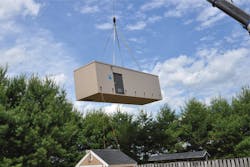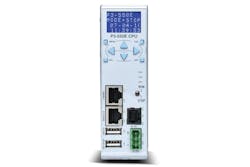Process skids are created by taking various processes and fitting them onto a skid. These processes are often smaller versions of large-scale plants, for example a wastewater treatment skid processing 5,000 gallons per day (see top photo), as compared to a municipal wastewater treatment plant processing millions of gallons per day.
In other cases, a process skid is built to produce only the relatively small amounts of a product needed for a particular application. An example would be a skid producing sulfur trioxide from sulfur for injection into a coal-fired power plant stack to improve electrostatic precipitator operation.
Smaller versions of process skids such as well pumps can easily be moved with a pallet jack, while larger versions such as a wastewater treatment skid must be lifted with cranes.
Process plants are often controlled by complex and expensive distributed control systems, but these systems are not suitable for process skids because a typical skid will have about 10 to 100 input/output (I/O) points, as opposed to a process plant with thousands of I/O points. Applying a distributed control system to a process skid would thus be overkill and much too expensive.
Although process skids do not have a lot of I/O, many have demanding automation requirements because of the complexity of onboard operations. For example, the process skid shown in the top photo must operate accurately and reliably at flow rates of 5 to 100 percent of capacity. Most process skids will have one or more proportional–integral–derivative (PID) control loops and many have extensive requirements for communications and data handling.
This article looks at how these and other requirements drive process skid controller selection.
Figure 1. Selecting a family of similar PLCs for process skid automation, such as AutomationDirect’s Productivity series, allows designers to closely match PLC capabilities to skid requirements (Above graphic and all following graphics courtesy of AutomationDirect).
Pick the right family
Perhaps the most important requirement for a process skid controller is scalability, often best accomplished by selecting a family of programmable logic controllers (PLCs) as shown in Figure 1. Using a family of PLCs allows the process skid builder OEM to scale from small to large applications with the same base hardware platform, and with the same PLC programming software. This is important because many OEMs build process skids to handle a wide range of production, and it is much more cost-effective to closely fit the PLC cost and capabilities to the application requirements, as opposed to using a one-size-fits-none approach.
If the right family of PLCs is selected, each controller can be programmed using the same software (see Figure 2). In the best case, the software will allow the entire application program to be created before the PLC is selected, which allows the designer to select the PLC with just the right capabilities, and no more.
A family of PLCs will typically use the same I/O, with the higher-end PLCs in the product line sometimes offering more options. This simplifies design of the control panel because wiring to and from the I/O will be similar in all cases, and it also reduces stocking requirements.
One of the main reasons process skids are growing in popularity is the ability to test the skid prior to shipment. This is opposed to stick-building a process unit on site, with testing not able to be performed until startup. The selected PLC family should therefore support shop testing of the skid by offering some degree of simulation for those parts of the process that cannot be run off-site, such as real-time control of a flow loop involving potentially hazardous chemicals, as with the aforementioned sulfur trioxide skid.
Figure 2. AutomationDirect’s Productivity Suite PLC programming software can be used to program the entire family of Productivity PLCs.
Real-time process control
A process skid is often small in scale but demanding in terms of real-time control requirements. Most skids will have one or more loops requiring PID control, so this capability is a must for a process skid controller, and the PLC must support the total number of loops on the skid. PID auto-tuning can expedite startup and commissioning by automatically generating proportional, integral and derivative values.
Process control applications can get program-intensive, so the selected PLC needs to have ample programming capacity and the processing power to crunch calculations, while still quickly executing the basic ladder program and updating I/O. Speaking of I/O, expandability of both local and remote I/O facilitates scaling up for larger applications.
Flexible math functions allow mixing of variables and constants with mathematic operators to solve equations. Statistical analysis (minimum, maximum, median, sum, average) greatly simplifies the creation and use of common formulas needed in many applications. Data arrays, both one- and two-dimensional, are lifesavers when tracking product or data through a process or when storing and loading large recipes and menus.
Remote operation requirements
Process skids are often located in remote sites and are expected to run unmanned. This means the PLC must have the ability to securely communicate over the internet. This requires an Ethernet port and support for hardwired, satellite and cellular communications.
One of the most common remote connectivity options highly recommended for secure connections is a Hosted VPN router — using connectivity options such as Gigabit Ethernet, wireless or cellular. As shown in Figure 3, these types of solutions not only provide an easily configured and secure connection, they also provide an optional Industrial Internet of Things (IIoT) solution with built-in, cloud-based data logging.
Figure 3. AutomationDirect’s STRIDE SiteLink Secure hosted VPN solution for IIoT connectivity
Another option for remotely accessing the PLC is a built-in web server. Enabling this feature provides a quick look at PLC health by viewing system tags. It also provides the ability to view, download or delete data log files currently on the removable memory device, preferably at USB drive or microSD card.
To monitor just a few data points without the need for investment in a full human machine interface (HMI) or supervisory control and data acquisition system (SCADA), an app may be the best solution. An app allows the user to connect a mobile device such as a smartphone or tablet to remote PLC systems using Wi-Fi or cellular network connections. The remote user can monitor tags preconfigured for remote access inside the tag database of the PLC program.
Playing well with others
Another popular application for process skids is in existing plants, requiring tight integration between the skid’s PLC and the plant’s control system. If multiple process skids are supplied to a plant by one OEM, then communications among the PLCs on each skid will be needed.
Multiple communication options simplify automation system integration between the PLC and other control systems. The PLC’s central processing unit (CPU) should include multiple Ethernet ports supporting multiple Ethernet protocols to assist with this integration (see Figure 4). Modbus TCP & EtherNet/IP are two of the most commonly seen protocols in the North American industrial automation market, making support for these two protocols extremely important.
In applications where skids are integrating with existing applications or other skids controlled with the PLCs discussed in this article, quick integration can be implemented via a proprietary network to quickly and easily share data among PLCs.
Figure 4. Process skids are often installed in existing plants, requiring tight integration with control systems. This AutomationDirect P3K PLC addresses these requirements by providing a variety of communication ports including two for Ethernet, RS-232 serial, RS-485 serial and USB.
Data handling needs
No matter where a process skid is installed, at a remote location or in-plant, extensive data handling capabilities are often required. Therefore, a PLC’s CPU should have an integrated data logging port where a removable USB drive or microSD card can be inserted. This feature serves the growing need for capturing process skid data and making it available to those who need it so they can make the necessary adjustments to prevent a process from getting "out of control" or running outside of the statistical process control limits.
Ideally, built-in data logging will provide tracking and recording of data from up to 64 unique tags, and these data values should be written to time-stamped files on the USB drive or microSD card. This USB/uSD device should be removable to allow manual and local retrieval of files, and access to these files should also be provided through the CPU’s built-in web server. With the appropriate network and security provisions, these .CSV formatted files can be viewed, downloaded and even deleted to free up space for additional files — all from any web browser.
Conclusion
Process skids have unique controller requirements in terms of scalability, real-time control, remote operation, integration with other control systems and data handling. The right controller, usually a family of PLCs, will allow skid builders to satisfy these requirements in a cost-effective manner while minimizing startup and commissioning time.




